 Traduzca esta página al español
usar FreeTranslation.com
Traduzca esta página al español
usar FreeTranslation.com 
 Traduire Cette Page A Français
utilisation FreeTranslation.com
Traduire Cette Page A Français
utilisation FreeTranslation.com 
 Übersetzen Sie Diese Seite Zu Deutsch
Gebrauch FreeTranslation.com
Übersetzen Sie Diese Seite Zu Deutsch
Gebrauch FreeTranslation.com 
Gigantopithecu or Big Foot?
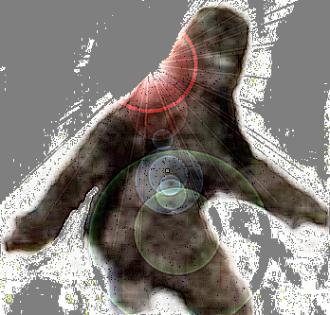
"We need to see clear locomotion to make a decision. That's why the Patterson film is so
convincing--muscle movement, and fluid gate."
This photo is from the incredible video shot by Roger Patterson and Robert Gimlin
in 1967. Both men lived near Yakima, Washington State. Patterson had been involved in
the search for the elusive Bigfoot or Sasquatch for many years and had written a book
on the subject entitled Do Abonimable Snowmen Of America Really Exist? In this book,
he calls attention to the significant amount of evidence that supports the creature's
existence. Gimlin, a highly experienced outdoorsman, was a close friend of Patterson
and agreed to accompany him on a wilderness expedition to search for the creature.
Equipped with a 16mm hand-held Kodak movie camera, the two searchers set out on
horseback in October, 1967 and explored the wilderness regions in northern California.
They concentrated their search in the area near Bluff Creek which is in the Six Rivers
National Forest. Bluff Creek itself, is about 38 air miles south of the California/Oregon
border and 18 air miles inland from the Pacific Ocean. This region was selected
because Bigfoot footprints had been found there in prior years. A road was
constructed into Bluff Creek in 1957, opening the area, which up to that time
had been remote wilderness. Road construction workers noticed large human-like
footprints in the soft soil which were reported to the press by Jerry Crew in
October, 1958. The word "Bigfoot" was used in the press release and has now
become a common name for the creature. Subsequent investigations at that
time revealed tracks of six different sizes, indicating that a number of creatures
frequented the area. Footprint sizes ranged from 12¼ inches to 17 inches long.
In the early afternoon of October 20, 1967 Patterson and Gimlin spotted
a female Bigfoot down on the creek gravel sandbar. Patterson's horse reared in
alarm at the sight of the creature, bringing both horse and rider to the ground,
Patterson pinned below. Being an experienced horseman, he quickly disengaged
himself and grabbed his camera. While running toward the creature, Patterson
took 24 feet of colour film footage. During this time, the creature quickly but
calmly walked away across the sandbar into the woods. In the meantime, Gimlin
observed the whole scene, rifle in hand, in case his friend was attacked by the
creature. The men had previously agreed that under no circumstances would
they shoot a Bigfoot unless in self-protection. The creature, estimated to be 7
feet 3½ inches in height and weighing 700 pounds, left footprints 14½ inches
long by 6 inches wide. In that part of Bluff Creek, there is a sandy clay soil
with a blue-gray tinge. This type of soil holds footprints remarkably well for
a long period of time.
Fearing a possible confrontation with the creature and perhaps others
of its kind, the two men decided not to pursue their prey into the forest. They
reasoned that they had photographic evidence of its existence and did not want
to put the creature or themselves in jeopardy.
The film has been studied by many scientists throughout the world who
continue to remain divided on the authenticity of the sighting. Roger Patterson
died in January, 1972 steadfast in his belief in the creature's existence. Robert
Gimlin, who now resides in Yakima, also continues to maintain that what he saw
was the elusive North American Bigfoot. To this time, no firm evidence has
surfaced to cast a doubt on this truly amazing discovery
From: Internet Virtual Bigfoot Conference Digest, 1996, V2 #111. Watch the video
at Patterson
and see the rest of the story.
Hoax? Watch this video..Patterson Bigfoot and this
Enhanced version.
and from the National Geographic channel
BigFoot
No scientists or qualified experts have
ever debunked the Patterson footage.
It has never been shown to be fake. On the contrary, every scientist who has
studied the footage either says it shows a real, unclassified species, or that a
conclusion cannot be made.
Close scrutiny and analysis of the Patterson footage almost always
transforms scientific skeptics into supporters for more research into the subject.
see
Debunking?
Bigfoot sightings in North America began in the early 1800s
apparently, though newspapers of that
time often printed hoax stories, so one cannot be sure. The first of many bigfoot sightings began
with an 1811 account near Jasper, Alberta, Canada by a fur trader by the name of David
Thompson. He claimed to have found four-toed, strange footprints in fresh snow.
from Bigfoot sightings
 "We are seeking comparative images of a skinny, mangy bear, bent over and
smelling the ground, as you see in this image. The people we have spoken with so
far who have spent a great deal of time with both primates and bears (mainly
zoo people) say this figure looks much more like a healthy primate smelling the
ground than like a skinny bear smelling the ground.
"We are seeking comparative images of a skinny, mangy bear, bent over and
smelling the ground, as you see in this image. The people we have spoken with so
far who have spent a great deal of time with both primates and bears (mainly
zoo people) say this figure looks much more like a healthy primate smelling the
ground than like a skinny bear smelling the ground.
If the figure is a 'skinny mangy bear' bent over, then it should be fairly easy
to replicate with photographs of such. So we are seeking images of a skinny, mangy
bear in this same posture?
More photos.. Bigfoot Research Org
Jacobs photos
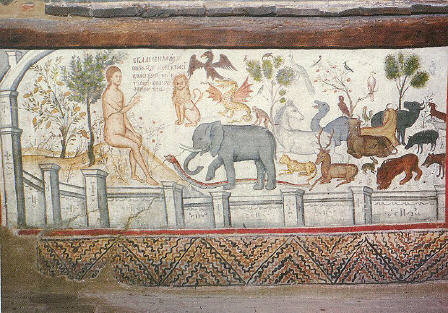 This painting shows Adam of the bible covered in hair. Is this
how he really was? Accordingly, before Adam eats the forbidden fruit, he is shown as living with
and as the animals and wearing no clothes - instead his body is covered with hair.
This painting shows Adam of the bible covered in hair. Is this
how he really was? Accordingly, before Adam eats the forbidden fruit, he is shown as living with
and as the animals and wearing no clothes - instead his body is covered with hair.
No other creature on Earth has a soul except man,
as God said, men are made in the image of Him, which is pure 'LIGHT' ( Soul ). Humans
today take this for granted. Go back and read Genesis again...We think you were created by God.
You are not evolved from some ape even if the DNA is similar.
Anthropologists have failed miserably to produce fossil evidence
of man's 'missing link' with the apes and there has been a growing
recognition of the complexity of organs such as the human brain.
In November 1859, Charles Darwin published a most dangerous
idea - that all living things had evolved through a process of
natural selection. Although there was almost no mention
of mankind in Darwin's treatise.
Darwins co-discoverer Alfred Wallace was less reluctant to
express his views. Wallace himself was adamant that 'some intelligent
power has guided or determined the development of man'.
But then you have HOMO ERECTUS, which represents a long line of fossils found
in eastern Africa, the Middle East and southern and southeastern Asia (where the fossils are
called Java Man) from about 1.7 million to 200,000 years ago. Was Java Man really Human?
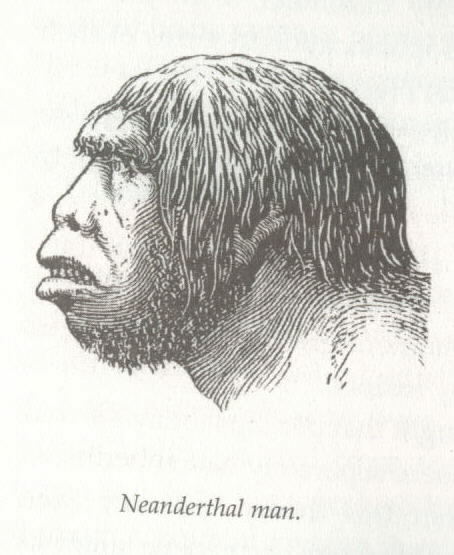 Is this Adam?
Is this Adam?
This says, HOMO NEANDERTHALENSIS, which lived from about 250,000 to
30,000 years ago, is the last species to diverge from the human line prior to the emergence
of modern humans, and the last species of hominid to have gone extinct. Some experts
claim that modern humans and Neandertals shared genes and habitats right up until about 30,000
years ago, but this is a minority view falling ever further into empirical complications.
Neandertals
The extinction of Neandertals coincides in most geographic regions with the arrival of
modern humans and the most recent Ice Age.
But humans did not evolve from these.
'MONSTERQUEST' ON HUNT FOR SASQUATCH
By MELISSA JANE KRONFELD
Incredible Show. November 9, 2007 -- THE History Channel may have discovered
the missing link.
In its new show "MonsterQuest," an adventurous group
braved the wilderness to see if "Big Foot" actually lives in Ontario, Canada.
Scientists Kurt Nelson and Jeff Meldrum spent five days with a video and audio crew
at a cabin in the utterly remote Snelgrove Lake, pulling DNA samples from the trap
and exploring the forest.
The show has caused a stir among enthusiasts because it has gotten so close to
proving the Sasquatch monster may, in fact, exist.
The show made "contact" with the thing on its last night of filming.
"A stone was thrown at about 2 a.m.," executive producer Doug Hajibeck told The Post.
"That stone hit like a bullet. It was thrown with amazing accuracy."
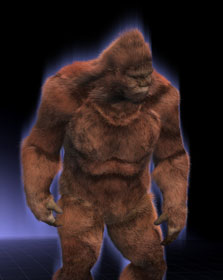 The crew threw a stone back and, in a matter of minutes, a second stone was
launched at them.
The crew threw a stone back and, in a matter of minutes, a second stone was
launched at them.
"I was really scared, and I felt the adrenaline," said Hajibeck. "When we threw that
rock into the woods and then it got sent back, my heart raced."
Blood, tissue and hair discovered later on a bear trap outside the cabin was tested.
The hair did not match any known North American bear or animal and tests showed
an uncanny similarity to human DNA with one exception: the irregular DNA matched
that of a primate.
"It is a show that presents and analyzes the evidence," said executive producer
Mike Stiller. "But, ultimately, it's up the viewers. Check your local listings for show times.
History Channel
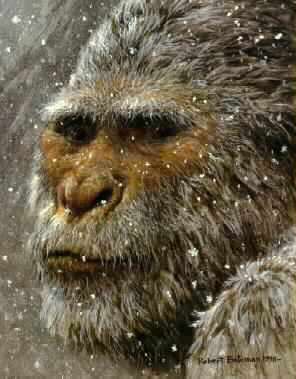 " I watched with baited breath last night
(nov 2007) Monster Quest, Sasquatch Attack in
Northen Ontario. The crew were attacked by a stone and log throwing person or
Sasquatch on the last night, 200 miles from anyone, at a flyin on a lake. They had
some DNA that was about two years old from a board full of galvinized screws to
stop predators like bears. The board had the imprint of a large foot unlike a bear.
The hair sample was not known. It had no Medulla and had a pointed end. It was
not bear nor human. It was unknown. The DNA once isolated from the contaminate
of the galvainzed screws and amplified showed itself to be a mutant human at best
and something unknown at present."
" I watched with baited breath last night
(nov 2007) Monster Quest, Sasquatch Attack in
Northen Ontario. The crew were attacked by a stone and log throwing person or
Sasquatch on the last night, 200 miles from anyone, at a flyin on a lake. They had
some DNA that was about two years old from a board full of galvinized screws to
stop predators like bears. The board had the imprint of a large foot unlike a bear.
The hair sample was not known. It had no Medulla and had a pointed end. It was
not bear nor human. It was unknown. The DNA once isolated from the contaminate
of the galvainzed screws and amplified showed itself to be a mutant human at best
and something unknown at present."
The chimp DNA Genome vs the Human Genome was off by 5 base pairs in this one
sequence. The Sasquatch/Mutant Human DNA was off by 1. They do not know what
it is for sure. Mutant human or a true Sasquatch. Since no Sasqutch DNA or
Genome is on profile but human mutations are they will continue to culture
and investigate. This particular mutation is at present unknown in the population
and therefore lends itself to being a interesting year ahead. Could Sasquatch be
geneticly more like us then even chimps or gorillas?
They will continue to grow the DNA and amplifiy it
for a year and then decide if they have a mutant human DNA or a Sasquatch DNA.
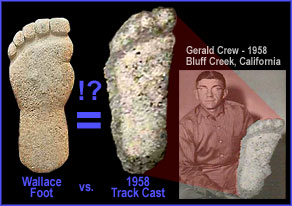 More evidence
More evidence
The words "yeti" and "abominable snowman" are
applied to several types of
hairy humanoids similar to North America's Bigfoot, but these creatures are distinct
from Bigfoot because they are reported from a different continent altogether. The
Himalaya Mountains of Tibet and Nepal are the homeland of these legendary creatures.
The two terms "yeti" and "abominable snowman" are sometimes applied to creatures
from other remote areas of Asia as well. Cryptozoologists and other serious
researchers prefer the term "yeti" over "abominable snowman" because "yeti"
sounds more scientific and because it is not based on a mistranslation of a native
word, as "abominable snowman" is.
The most picky cryptozoologists refer to each individual type of yeti by its own native
name, dzu-teh for the biggest, hulking giants who sometimes walk on all fours and seem half
bear, half ape, meh-teh for the "classic" yeti that stands about six feet tall and has a pointed
top of the head, and teh-lma
for the three-foot-tall frog-eating yeti that makes its home
in steamy jungle valleys between mountains (sometimes thought to be a juvenile yeti by
researchers).
The teh-lma is the most human-like of the yetis and is thought to be a race of primitive
humans by some researchers, compared to the proto-pygmies. It is also the most
ignored of the yetis. Very little research has been focused on it recently, although
several decades ago, when it was lumped in with the meh-teh more often than not,
this little yeti was more in the spotlight. The dzu-teh is thought by many researchers
to be a bear. It has claws and carnivorous habits, in addition to its bear-like appearance.
However, many cryptozoologists think that, if it is a bear, it must be a new species of
bear, because the descriptions don't sound like any known species.
The meh-teh is the subject of the most research, and is the only variety of
yeti that most people hear about these days. Whenever you've read about the yeti
before, it is likely you were reading about the meh-teh, the classic yeti that sounds
most similar to Bigfoot. It looks something like a cross between a gorilla and a man.
It could not easily be mistaken for a bear. Even though it has long, shaggy hair, it is
actually supposed to be a valley-dweller, like all other varieties of yeti.
The snow-capped peaks don't contain enough food for such a creature to live
there, but it is said the meh-teh often has to go through high mountain passes
to travel from one valley to another, where it becomes highly visible to human
observers and sightings are most likely to take place. In its forested, remote valleys,
it is supposed to be nearly impossible to locate, living in a remote territory much like
the panda, which eluded researchers for sixty years after its discovery.
Even though the yeti (at least the meh-teh) is one of the best documented of the
hairy humanoids, it is also one of the most disputed. Native folklore has heavily
obscured whatever real animal may lie behind the mythology. According to legend,
the yeti is a spiritual being, not an animal. It is sometimes worshipped, attributed
with many supernatural powers, and is said to interbreed with humans.
In addition, some legends say that there is no actual breeding population of yetis.
Instead, each yeti is actually the transmogrified quasi-solid ghost of a dead human.
Other mythology states that the yetis are actually demons that have been assigned
to guard mountains, so that humans do not ascend to the peaks and disturb the gods
who live there. If this is true, then the yetis have failed miserably in their task to
keep people from climbing Mt. Everest.
With western observers involved, the picture can get clouded too. The yeti has
been shown to be confused with actual humans, bears and even suggestive-looking
rocks on some occasions.
 Bigfoot" is a term that is applied in two ways.
In its widest sense, it is applied to every type of hairy humanoid from all over the world,
regardless of that hairy humanoid's characteristics. In other words, it is a catch-all category
that is applied to every variety of legendary ape-man by those who don't know better.
In its more correct sense, "Bigfoot" applies to a certain type of hairy humanoid that is
frequently reported in the Pacific Northwest area of America (roughly the states of Washington,
Oregon and the northern part of California) and also found in similar habitats in western Canada,
possibly as far north as Alaska. This type has a relatively stable set of characteristics and is
often viewed as the standard Bigfoot.
Bigfoot" is a term that is applied in two ways.
In its widest sense, it is applied to every type of hairy humanoid from all over the world,
regardless of that hairy humanoid's characteristics. In other words, it is a catch-all category
that is applied to every variety of legendary ape-man by those who don't know better.
In its more correct sense, "Bigfoot" applies to a certain type of hairy humanoid that is
frequently reported in the Pacific Northwest area of America (roughly the states of Washington,
Oregon and the northern part of California) and also found in similar habitats in western Canada,
possibly as far north as Alaska. This type has a relatively stable set of characteristics and is
often viewed as the standard Bigfoot.
The standard Bigfoot has a rather consistent appearance. Adults are described as six to nine
feet tall, heavily built, and muscular, with large feet and a sagittal crest on top of the head,
giving the head a somewhat pointed, elongated look, like a bullet. The forehead itself is
generally sloping, suggesting a brain that has more in common with apes (or very
primitive men) than modern humans. The entire body is covered with thick, shaggy
fur of about the same length, without longer hair on the head. The body shape is
often compared to a professional football player or a bodybuilder, with large muscles
and a solid physique. Footprints measure fifteen inches long on average, with five toes.
Behavior towards humans can be aggressive, but is seldom anything worse than a threat display.
The creatures are often sighted in family groups, with arrangements that would
suggest they seem to follow the human rule of pair-bonding with one male and one female
staying together to raise their young. They seldom use tools more sophisticated than a
branch, do not wear clothing, and cannot speak, although they have a wide variety of
calls that might count as language to another Bigfoot. They seem to be highly nomadic,
occasionally sheltering in caves, but seeming to not stay in one area longer than a night
or two. Those who believe in them think that their diet is probably mostly plant food such
as tender leaves and acorns, along with some meat sources such as snails, frogs and
scavenged deer carcasses.
This standard Bigfoot is not the only
hairy humanoid to be reported from the
Pacific Northwest of North America. Other beings that do not fit the standard model
are also sighted, including true giants, marked hominids and many types of BHMs (big
hairy monsters) of a decidedly paranormal character.
In recent years, the efforts of serious cryptozoologists to make the discipline
sound more respectable has led many to discard the term "Bigfoot" as unscientific,
replacing it with sasquatch. Some other researchers use "Bigfoot" for standard Bigfoot
reports from the Pacific Northwest and reserve "sasquatch" for the Canadian Bigfoot.
However, in general the two terms can be used interchangably.
Hairy humanoids are roughly human in form, but are largely or wholly covered in fur
or hair. In other words, most of these creatures could be broadly described as
ape-men. The most famous hairy humanoid is Bigfoot, but there are countless
other cousins of Bigfoot found in legends and sightings from around the world.
Some people use the term "Bigfoot" for any type of hairy humanoid from any place
in the world, but the proper use of "Bigfoot" restricts the term to creatures supposed
to live in North America.
The Race of Giants - Gigantopithecu
Anthropoligists have also found a race of giants.
But these giants are not human. They have tried to connect these with humans
stating that they are our ancestors. WRONG!
The Jawbone and teeth of an adult modern human man on the right compared to that of a
male Gigantopithecus on the left. Teeth and jaws range from twice to four times the size of
the 'modern man's'.
Was There a War Between the Els (Human Giants) and The Reptilian Civilizations of Long Ago.
Some Believe that There was a conflict of this kind in Ancient Times which drove
the Reptilian Civilization deep into the Inner Earth or back to where they originated from
...Alpha Draconis and/or Altair in the Constellation Aquila. This conflict or war was a
Species War between the Evadamic Seed and the "Serpent/Draconian" Seed.
Some believe that the Giants were closely allied with a race of Pre-Scandinavian
Nordics who live within the Earth, in what is mythologically known as Agharti or 'Shambhala'.
The Giants are defined as 'Els' based on the mythed 'EL-der Race, a human branch
tied-in with the Evadamic heritage, having a very tall stature averaging from 9-12 ft.
in height.
However, the Reptilian Race, not to be confused with the El Race also has been
described as tall in stature and are very anti-human wishing once again to take control
over the human race...if not annihilate it all together. The Reptilian also has the capabilities
to 'Shape-Shift' ..or manipulate the mind into creating an impression of appearing human.
The Assyrian texts, places emphasis on the number seven to the Goddess-worshipping
societies, which in ancient text, refer to seven gateways. The ancient civilizations most
often had seven gateways leading into their cities.
It is also interesting to note that there are seven electronic layers around the atomic
proton, recalling the sevenfold planetary system and its metallic correspondences,.the
music scales, colors, etc. Let us then add to this the seven fundamental constants: E,
charge of the electron; G, constant of gravitation; M, mass of the proton; H, Planck's
constant; C speed of light; G constant of gravitation; A, cosmmological constant.
The evidence strongly suggests that this early culture was very much aware and did
use physics and the science of genetics. Giant skeletons
"You must completely destroy all the places where the nations you dispossess have served
their gods, on high mountains, on hills, under any spreaking tree; you must tear down
their altars, smash their pillars, cut down their sacred poles, set fire to the carved
images of their gods and wipe out their name from that place" (Deut. 12:2,3)
Do you want more proof that the Children of the Giant 'Anakim' still lived on Earth in
the time of Saul and David?.. Nm:13:32:, Nm:13:33:, Deuteronomy 2:19, Dt:2:20, Dt:2:21:, Dt:2:22:, 1Sm:17:4:,
1Sm:17:71, 2Sm:21:18, Chr:20:4:, 1Chr:20:5:, CHR 20: 4-8, 1Chr:20:6:, 1Chr:20:7:, 1Chr:20:8:,
Although these are clearly
'giant gorillas'
scientists try to link them to humans. As our story unfolds, you will see that that isn't possible.
"Gigantopithecus
was in the landscape with homo erectus up until 300,000 years ago,
at a time when humans were undergoing a major evolutionary change.
Guangxi province in southern China, where the Gigantopithecus fossils were
found, is the same region where some believe the modern human
race originated." and see.. The discovery
 Believers in the existence of the Yeti or "Abominable Snowman" and Bigfoot have
theorized that these creatures could be present-day specimens of G. blacki. Without
additional evidence, this must be regarded as highly speculative.
Believers in the existence of the Yeti or "Abominable Snowman" and Bigfoot have
theorized that these creatures could be present-day specimens of G. blacki. Without
additional evidence, this must be regarded as highly speculative.
Due to the likelihood that G. blacki co-existed with anatomically modern H.
sapiens, it is possible that encounters with the creatures over a hundred thousand
years ago may have become, through oral tradition, the legends
about the Yeti or Bigfoot still passed around today (Park, 177-178).
There was a race or group of people found in Australia called
"meganthropus"
by anthropologists. These people were
of very large size — estimated between 7 to 12 feet tall, depending on what source
you read. These people were found with mega tool artifacts, so their humanness
is difficult to question. Four jaw fragments and thousands of teeth have been
found in China of "gigantopithecus blacki" — named after the discover. Based on
the size of the teeth and deep jaws, its size has been estimated at around 10
feet and as tall as 12 feet, 1200 pounds.
Most cryptozoological explanations for them fit in three categories. Some think these
creatures are missing links, other researchers think they are primates, and yet others
think they are primitive humans. In the "primates" camp, the presumably extinct giant
ape Gigantopithecus
has become a favorite candidate. In the "primitive humans" camp,
Neanderthal man is the favored explanation for hairy humanoid sighting
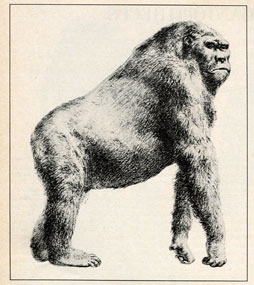 Another giant race called
'Paranthropus robustus'
was originally discovered in Southern Africa in 1938. The development of P. robustus,
namely in cranial features, seemed to be aimed in the direction of a "heavy-chewing
complex". Because of the definitive traits that are associated with this robust line of
australopithecine, anthropologist Robert Broom erected the genus Paranthropus and
placed this species into it.
Another giant race called
'Paranthropus robustus'
was originally discovered in Southern Africa in 1938. The development of P. robustus,
namely in cranial features, seemed to be aimed in the direction of a "heavy-chewing
complex". Because of the definitive traits that are associated with this robust line of
australopithecine, anthropologist Robert Broom erected the genus Paranthropus and
placed this species into it.
Mystery Primates vs. Big Hairy Monsters
In addition to the three main kinds of explanations, there are two main classifications
for these cryptids. One category contains all the more tame, normal specimens that have
some respectability in the eyes of science, while the other category contains all the weird
things that seem supernatural, out of place, or just plain silly.
The more respectable category includes Bigfoot, the yeti and other ape-men that
seem biologically plausible. These beings typically live in remote areas such as the Pacific
Northwest of America or the Himalaya Mountains of Tibet, areas where it is at least
somewhat believable that a large mammal could go undiscovered. They usually have
footprints with five toes, and they seem to generally behave in ways that a biological
animal ought to behave.
The second category includes a wide assortment of less plausible creatures that
are collectively referred to as "hairy bipeds" (HB for short) or "big hairy monsters"
(BHM for short). BHMs are often found in heavily populated areas, places where few
scientists expect that large mammals could live undetected. BHMs frequently act in
ways that we would not expect from real ape-men, such as wearing absurd bits of
clothing. They often have ghostly or paranormal characteristics, such as glowing
red eyes, the ability to walk through solid objects, or the ability to suddenly vanish.
Like hallucinations, they are often bulletproof. In addition, they often present physical
features that are biologically absurd, such as being the size of an elephant, having only
three toes, or combining the usual ape-man look with a wolf's head, a goat's legs, or
a fishy tail. A good example of an HB or BHM is the headless big hairy monster that
has been associated with Mothman sightings. An animal that lacks a head is the
pinnacle of biological absurdity.
BHMs are more often investigated by paranormal researchers and ignored by
mainstream scientists, while the more respectable varieties of hairy humanoids such
as Bigfoot are the subject of much scientific debate and draw more research money
to their cases.
see..The Cryptid Zoo: Hairy Humanoids
"Missing link" is a term used for the one or more species of ape-men presumed
to exist somewhere in the fossil record in order to complete the evolutionary chain
between the more intelligent, bipedal apes such as Gigantopithecus and the earliest
primitive species of humans. For many years, researchers have suggested that
Bigfoot or hairy humanoids in general may represent one or more surviving
"missing link" species.
The fossil record as a whole is rather spotty, so most scientists don't think
that the missing "missing link" fossils present any real problem or challenge to the
theory that humans evolved from apes. There are presumably countless individual
species that we will never find fossils of.
Recently, the idea has surfaced that the hominid/primate fossil record
is complete enough that we don't need to look anymore for a missing link. Many
scientists today think that there is no real gap between the most intelligent apes
in the fossil record and the most primitive types of people in the fossil record.
Along with this idea, explanations for Bigfoot and his fellow creatures have shifted
in two directions: some researchers favor the idea that Bigfoot is a bipedal ape
instead of an ape-man, while others favor the suggestion of a primitive, very
hairy human such as Homo erectus. A rare few researchers favor the idea that
hairy humanoids are hybrids of some sort, such as the
humanzee or possibly
hybrids between humans and neanderthals.
What we have here is scientific evidence that these creatures exist. However there are several
different types of bigfoot. That means several attempts to produce a 'worker' that could
be controlled and do what it's told were made by the Anunnaki. Apparently these were to ape-like
and they escaped into the wild hundreds of thousands of years ago. Once again the Anunnaki
theory is the only one that fits.
Some of the text on this page is copyright 2006 by Jamie Hall. Please use proper citation
if you are using this website for research.
Back to Forbidden forward 1
View My Guestbook Sign My Guestbook
Sign My Guestbook
NO PART OF THIS SITE MAY BE COPIED OR REPRODUCED, IN WHOLE OR IN PART
WITHOUT THE EXPRESS WRITTEN APPROVAL OF THE WEBMASTER.
c COPYRIGHT 1999 - 2009 C.I.C...ALL RIGHTS RESERVED.

"Great spirits have always encountered
violent opposition from mediocre minds"
-- Albert Einstein